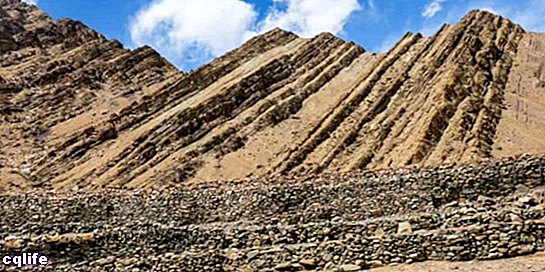We explain what a geological fault is, its types and its relationship with seismic movements. In addition, the main failures of the world.

What is a geological fault?
In geology, a fault a is a fracture or set of fractures in the large stone blocks of the lithosphere, which produce a discontinuity or relative displacement between the stone assemblages. This type of breakage occurs when the force of the tectonic movement overcomes the resistance of the materials of the I usually.
Failures are common in the planet, and are usually found on the edges of each tectonic plate, in addition to being involved in the tectonic formation of moutains (orogenesis). In addition, these ruptures can be vertical or horizontal, or even occur in a diagonal direction, depending on the geological characteristics of the terrain.
In places where there are faults, seismic movements tend to occur, since the pressure of the tectonic plates shakes the stone blocks when resisting the movement, since there is no lubrication of any kind between them: the energy accumulates in the place and when released When one of the two rock blocks finally gives way, the seismic waves that we perceive on the surface are generated.
Thus, depending on whether they have moved and generated earthquakes at least once in the last 10,000 years or not, the faults can be considered active or inactive, respectively. The active ones, in addition, can be seismic (if they produce tremors) or asismic (if they do not produce them).
Types of geological faults

Faults are usually classified geometrically, that is, from the point of view of the relative displacement of the stone blocks involved, along a fault plane that can be vertical, horizontal or inclined. In this way, the failures are classified as:
Normal or direct failures. Those on which the gravity, that is, in which one of the stone blocks slides down the other, along an inclined fault plane.
Reverse faults. Those in which the opposite of the previous case occurs, that is, one of the stone blocks rises up from the other, along an inclined fault plane. The block that emerges is known as a thrust.
Elapsed, heading or tear failures. Those in which the displacement occurs horizontally, parallel to the course of the fault. Depending on the direction of movement, they can be of two subtypes:
- Sinistral or left directional, if the block moves to its left side.
- Dextral or right direction, if it does it towards the opposite side, the right.
Oblique or mixed faults. Those in which two of the three previous cases are combined, that is, the block moves down and to the right, down and to the left, up to the right or up to the left.
Rotational failures. Those in which one of the blocks, instead of moving, rotates on its axis. This can happen in three ways:
- In scissors, when the axis of rotation is perpendicular to the fault plane.
- In cylinder, when the axis of rotation is parallel to the plane of failure.
- In cone, when the axis of rotation is oblique to the fault plane.
In the last two cases, the fault plane is usually curvilinear.
Major flaws in the world
Some of the most famous fallas in the world are the following:
- San Andrés fault. A fault of around 1,300 km in length that crosses the states of California, in the United States, and Baja California, in Mexico. It represents the boundary between the tectonic plates of North America and the Pacific, and is famous for its devastating earthquakes, typical of the so-called Pacific Ring of Fire, to which it belongs.
- Ramón's fault. Active fault located east of the capital city of Chile, Santiago, at the foot of the Sierra de Ramón, from where it gets its name. It has a length of 25 km and a depth of 5 km, located in a north-south direction. Being a reverse fault, it is responsible for the creation of the nearby mountain range.
- Altyn Tagh fault. Gigantic fault of around 2500 km in length, boundary between the tectonic plates of Eurasia and the Indian subcontinent. Located 1,200 km from Mount Everest, it is the largest active strike fracture on the planet, and its last earthquake took place in 2008 in Sichuan, China, leaving more than 60,000 dead.
- Motagua fault. Located in Guatemala and the Mexican southeast, this fault follows the course of the Motagua River crossing Guatemala and Belize. It represents the separation between the tectonic plates of North America and the Caribbean, and causes numerous volcanic phenomena in Central America.
- Fagnano-Magallanes fault. Fault system located between the South American and Scotia tectonic plates, in an east-west direction to the south of Argentine Patagonia, from the western mouth of the Strait of Magellan, to the valleys of the Turbio River and the Irigoyen River. Its usual earthquakes do not exceed 4 points on the Richter scale, and the largest occurred in 1949, reaching 7.8 points on the scale.
